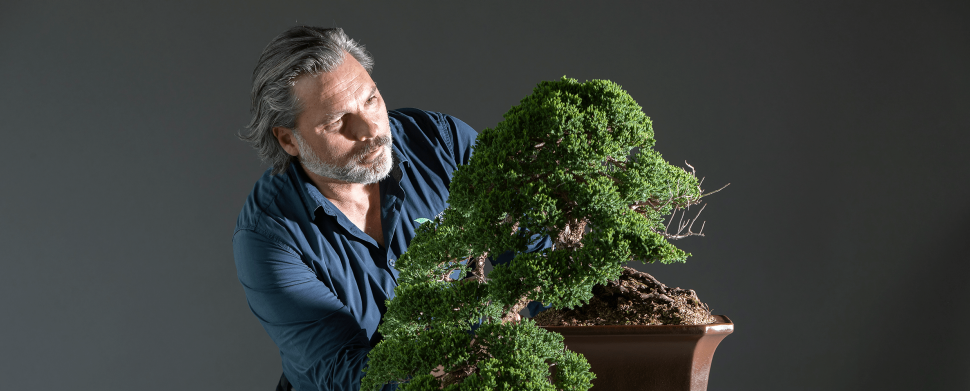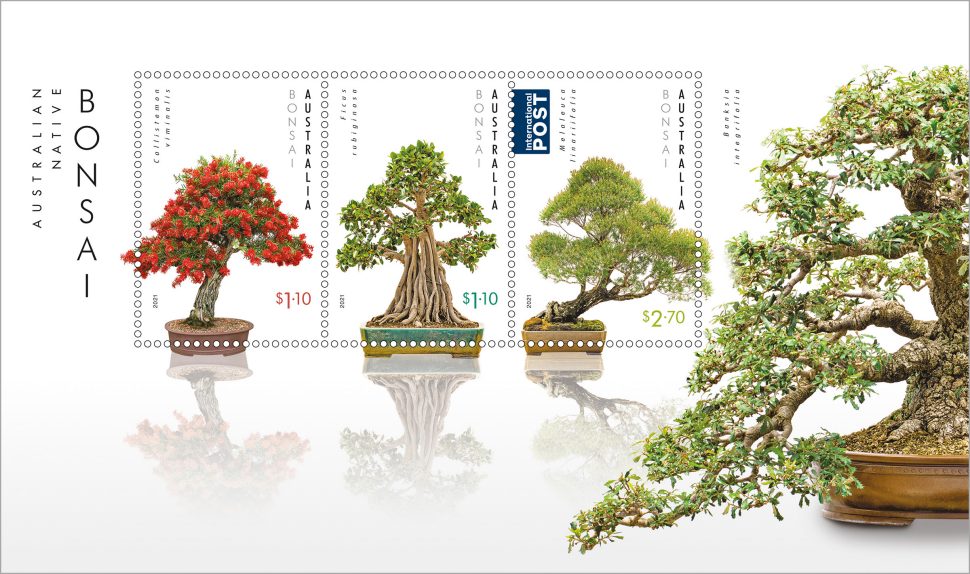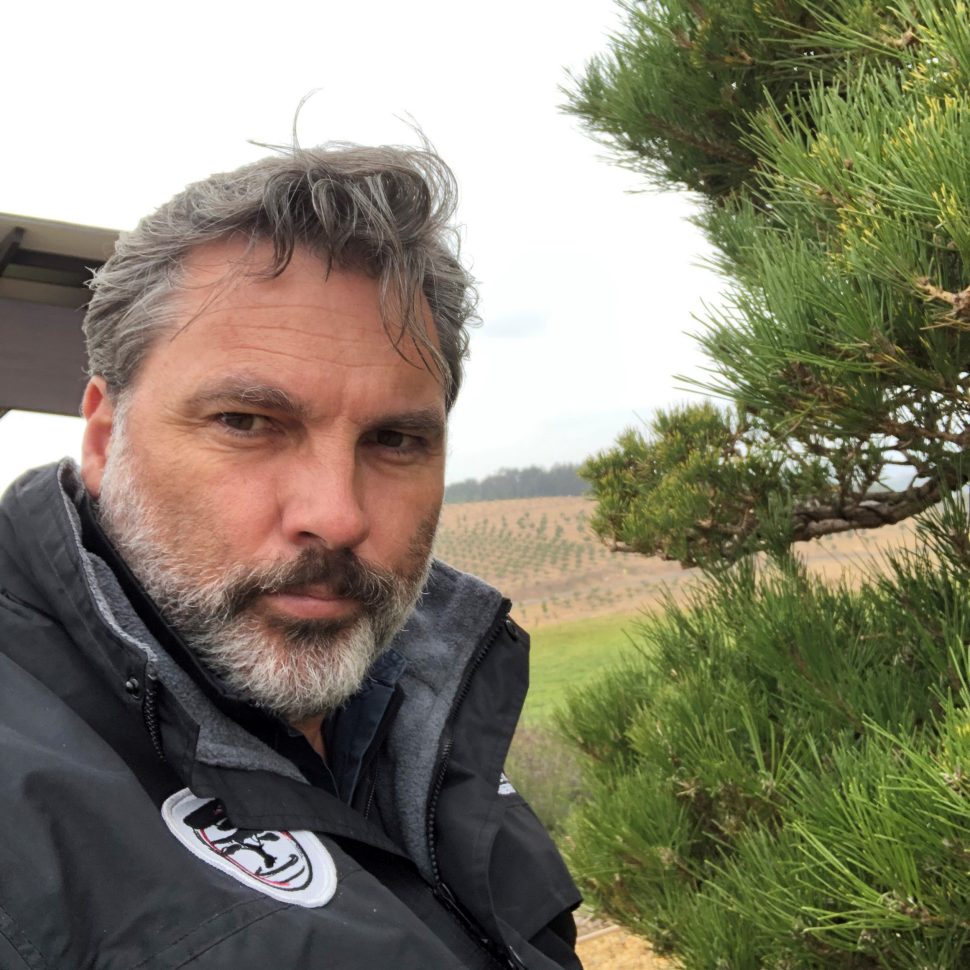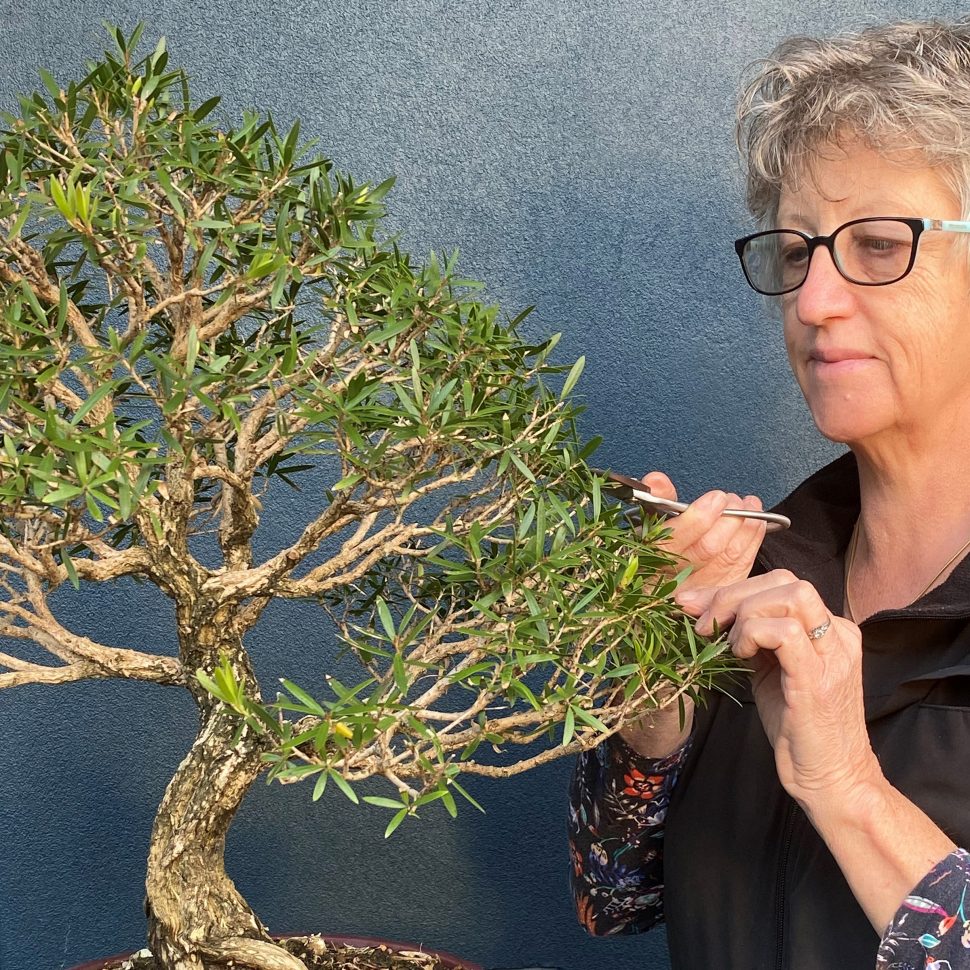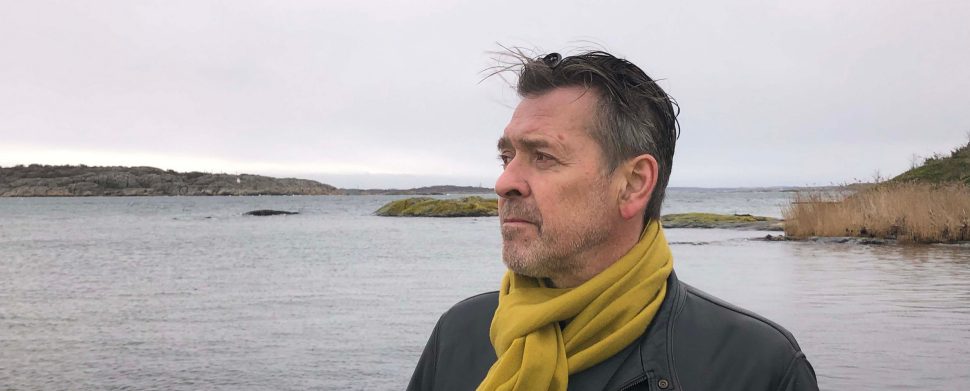The translation of the Japanese term bonsai is “planted in a container”. Using specialist tools, trees and shrubs are sculpted by an artist to create a miniature version of a mature tree living in the wild. Growing the plants in containers and shaping the branches and foliage creates the size, shape and style of each bonsai tree.
Creativity and aesthetics are an important part of the art form, and various techniques are employed by the bonsai artist to create an impression of age, such as downward-leaning branches that are thicker and longer towards the bottom of the trunk (given that new growth occurs at the top); a trunk that tapers from thick at the base to thinner at the top (for the same reason as previously stated); thick, exposed surface roots; and small leaves and flowers.
Bonsai has been practiced in Japan for at least 1,200 years. It originated from the even older Chinese practice of penjing, which is the art of and science of growing miniature landscapes in a pot or tray. In contrast, bonsai usually involves a single tree with a sparser presentation style. Bonsai presentation styles include formal upright (no bends in the trunk), informal upright (some curve and lean permitted), slanting (where the apex of the trunk falls between 10 and 45 degrees to the left or right), semi-cascading (where the trunk grows upwards and then downwards over the pot, but not below the base) and cascading (where the lowest branch falls below the base of the pot).
Featured in the Australian Native Bonsai stamp issue, which will be released on 27 July 2021, are three examples of Australian native plants as bonsai: a bottlebrush (Callistemon viminalis ‘Captain Cook’), in an informal upright style; a fig (Ficus ribiginosa), in a formal upright style; and a paperbark (Melaleuca linariifolia ‘Claret Tops’), in a slanting style. The minisheet features a banksia (Banksia integrifolia) in a semi-cascading style.
The trees featured in this issue are, or have been, housed at the National Bonsai and Penjing Collection of Australia (NBPCA), which is part of the National Arboretum, Canberra and is highly regarded globally. The NBPCA is a partnership between the ACT Government and the Australian bonsai community. The collection was officially opened on 28 September 2008 (at its original location in Commonwealth Park, Canberra).
There are approximately 120 bonsai and penjing specimens in the collection at any one time. Presently there are 64 bonsai and penjing in the permanent collection that have been donated by artists from around Australia. Trees from the NBPCA loans program make up the remaining numbers, ensuring a dynamic and ever-changing display for the 200,000 people who visit the NBPCA each year. (Loan trees stay with the collection for around two years on average, before being returned to the owners.)
As well as the ability to visit the collection every day of the year (except for Christmas Day), the annual Bonsai Week event involves guided tours, workshops, classes, demonstrations and discussion forums. The NBPCA has a team of around 60 volunteers who contribute approximately 130 hours of their time per week as a group as ambassadors and advisors, as well as to scout for new specimens.
The curator of the NBPCA, Leigh Taafe, was instrumental in providing the philatelic researcher who worked on this stamp issue with expert advice as well as access to specimens and photographs. Leigh has been involved with bonsai since 1984, initially as a hobbyist, then professionally since 2000 as proprietor of Ledanta Bonsai Nursery. Leigh began working with the NBPCA in 2010 as the assistant curator, moving to the curator role in 2013.
“I had an avid interest in gardening, along with my mother, from a very young age. She encouraged me to collect cacti, which was a good introduction to container gardening. I first became interested in bonsai after watching the original Karate Kid movie. It did not take long to fall in love with the sense of creation and nurturing that practising bonsai brings,” says Leigh.
“I now love sharing the artform with others, helping them understand what bonsai and penjing is all about, helping them interpret what they can see in the structure and composition of these art forms,” says Leigh.
“I often enjoy taking some time to stand near the entrance of the NBPCA and observe the expressions on visitors’ faces as they enter. Quite often our visitors have not seen bonsai or penjing to this standard and are quite amazed at the living works of art,” says Leigh.
Knowledge of miniature trees spread to Western cultures in the 1800s, including to Australia, when miniature trees were brought here by Chinese migrants. Post–World War II, soldiers brought home the ancient practice of bonsai from Japan. From the late 1960s, the practice of bonsai gained wide popularity, including the establishment of bonsai clubs, which led to the establishment of the Association of Australian Bonsai Clubs (AABC), in 1980.
The AABC is the national body representing 58 individual bonsai clubs throughout Australia and some in New Zealand. It holds national conventions, to promote networking, and invites internationally and nationally renowned bonsai masters and demonstrators to share their skills. Members of local clubs are also encouraged to participate as bonsai artists and demonstrators as part of the AABC’s visiting tutor program, which helps to lift the standard of bonsai across Australia and New Zealand.
The current president of the AABC, Dianne Boekhout, as well as immediate past president and Chairman of World Bonsai Friendship Federation, Lindsay Bebb, were of great assistance to the researcher on this stamp issue.
Dianne started her bonsai journey in the early 1990s, as an outlet from family and young children.
She attended an evening TAFE course, joined the Bonsai Society of Western Australia (BSWA) to learn more, and then progressed to attending national and international conventions in the USA, Europe, Japan and South East Asia. Dianne has held the position of President of the BSWA for more than 12 years.
“In the pre-internet era, you had to meet people in person and see trees in the bark!” says Dianne.
“I have always had an interest in plants, nature and gardening. I bought a bonsai book as a teenager, but in my 30s I saw a bonsai display at local shopping centre and wanted to know more,” explains Dianne.
“Belonging to a club offered great opportunity to meet local mentors, to share ideas and try new techniques. Bonsai brings all types of people together. It’s a relaxing activity: part creative art, part horticulture. It’s enjoyed by people from all demographics, ages and cultures and at various levels,” says Dianne.
Dianne says that there are many factors that go into deciding whether a bonsai specimen is of high quality: “Proportion is important, as well as having the look of a mature tree. It must be a thing of beauty, although any artistic concept must be balanced with ensuring the good health of the tree”.
Bonsai is, Dianne explains, very popular in Australia. While there aren’t a large number of professionals or specialist nurseries here, there are certainly some very skilled artists who are recognised on the world scale. This is perhaps why Australia is set to host the ninth World Bonsai Convention, in Perth, in October 2022 (delayed from 2021 due to the global pandemic). The plan is for delegates to come from all over the world to meet and greet over three days. Each geographic zone of the World Bonsai Friendship Federation provides a demonstrator who showcases their skills, including new trends. Coinciding with this will be a large exhibition, open to the public, of Western Australian bonsai creations. Many involve species not grown elsewhere, due to the biodiversity of Western Australia and Australia as a whole. Also displayed are suiseki (viewing stones) and photographs of high-class bonsai from other locations.
“We are limited by quarantine restrictions between some areas, so we are unable to have a truly national exhibition like other countries. Also, the pandemic has made the hosting of this event complicated and uncertain. It may need to be a limited convention, due to travel restrictions and bubbles,” says Dianne.
Regardless, Dianne is very pleased to see Australian native bonsai on stamps: “This is a first for Australian stamps and it makes me very proud!”
Leigh Taafe agrees:
“I have been passionate about sharing the art of bonsai and penjing in Australia, particularly with the use of Australian tree and plant species, so it is a very special moment to see trees from within our national collection being showcased via this medium. I hope that having our Australian native bonsai on Australia Post stamps will help gain the sort of recognition in Australia that this ancient art form deserves.”
The Australian Native Bonsai stamp issue is available from 27 July 2021, online, at participating Post Offices and via mail order on 1800 331 794, while stocks last.
This content was produced at the time of the stamp issue release date and will not be updated.
